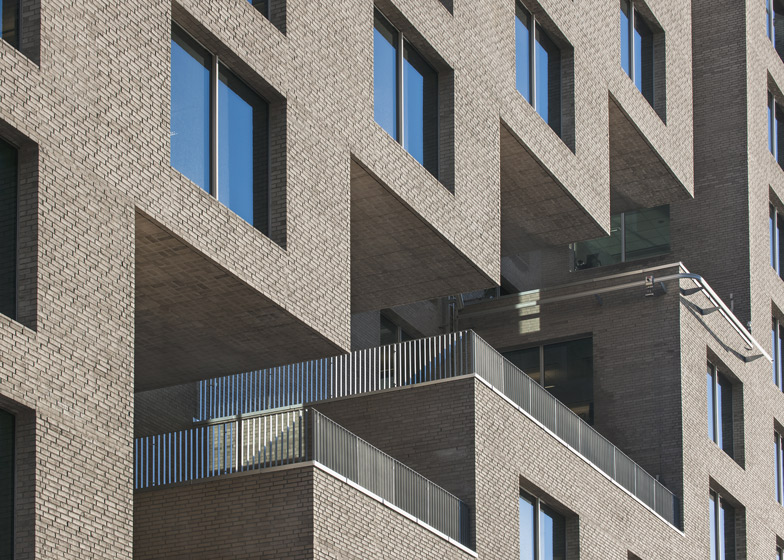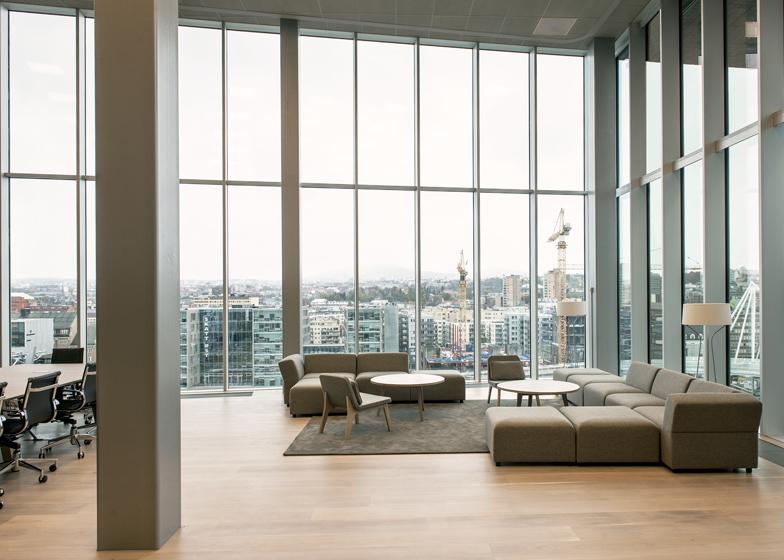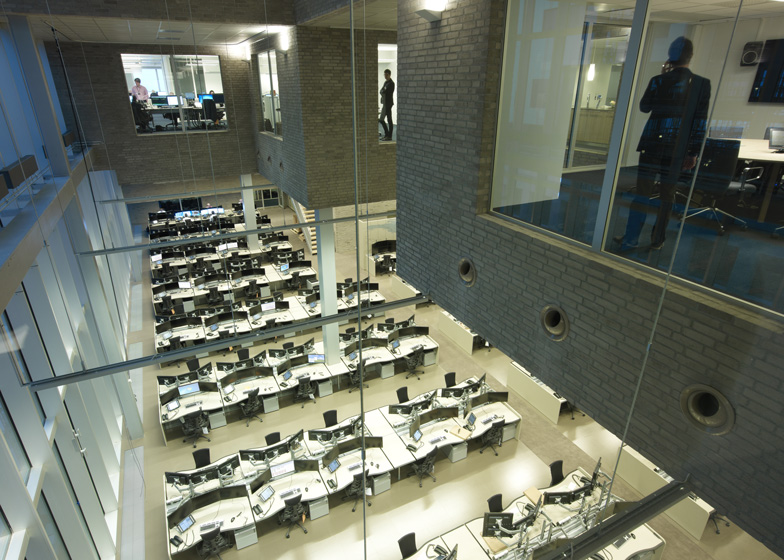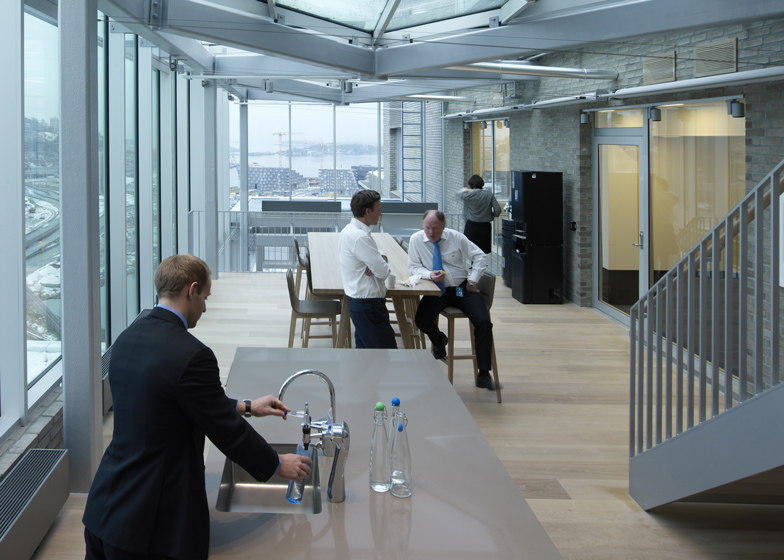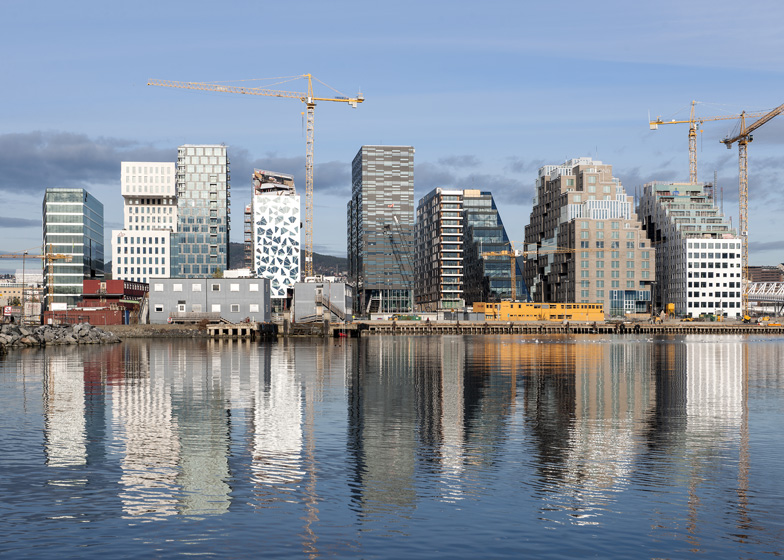Dutch studio MVRDV has given the new Oslo headquarters for Norwegian bank DNB a pixellated appearance by building a stack of brick and glass cubes (+ slideshow).

The irregular arrangement of the six-metre wide cubes creates recessed openings across the facade, which MVRDV has used to add sheltered terraces to each floor and a new route from the waterfront towards the nearby railway station.
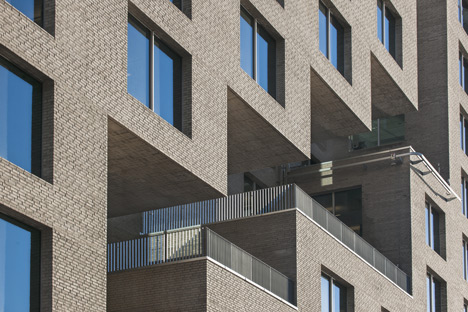
"We started with a massive slab and by removing pixels one by one we were able to create an arcade, terraces, a public passage, etcetera," project architect Jeroen Zuidgeest told Dezeen. "By carving out volumes, we made sure every floor has access to interior and exterior terraces."
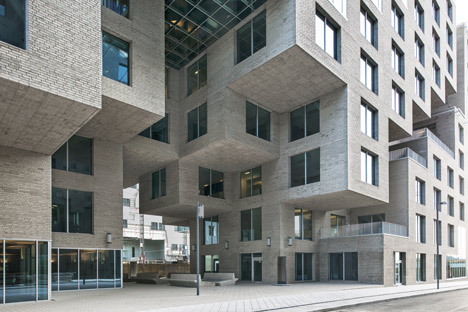
The DNB Bank Headquarters is located within the waterfront development of Bjørvika Barcode that MVRDV masterplanned in collaboration with Norwegian architects A-Lab and Dark Arkitekter. Each studio has designed one building for the bank and MVRDV's is the first to complete.
At 17 storeys high, the building provides over 2000 flexible work spaces for employees and each floor accommodates a series of glass cubes where staff can hold informal meetings, have lunches or take phone calls.
Wooden bridges and staircases connect the floors both inside and outside, and it is possible to walk up one side of the building to the canteen and then back down on the other side.
"On one hand, you have this proud, strong iconography, and on the other hand you're offered social spaces and human character on every floor," said Zuidgeest. "None of the floors are the same and when you manoeuvre through the building you experience how each floor has its own character and qualities; each one has its own surprises."
The building is already in use, although the complex is scheduled to open officially in May 2013.
Above: photograph is by Jeroen Musch
MVRDV has designed a few buildings with pixellated volumes, including a pair of skyscrapers that caused controversy for bearing a resemblance to the exploding World Trade Centre on 9/11. See more projects by MVRDV »
Above: photograph is by Jereon Musch
Photography is by Jiri Havran, apart from where otherwise stated.
Here's the full project description from MVRDV:
MVRDV completes DNB Bank Headquarters main building in Oslo
The central building of DNB’s new bank headquarter cluster developed by Oslo S Utvikling (OSU) is completed. The MVRDV designed main building has 17 unique floors and a surface of 36,500m2. The pixelated volume based on small-scale working units adapts to the various influences of the urban context, combining an efficient and flexible internal organisation with a variety of specific communal spaces such as the main entrance lobby, a transparent trading floor, a sheltered public passage, respect for urban view lines and collective terraces overlooking the fjord to the south. The glass and brick exterior expresses both the transparency and stability of DNB as a modern financial institution.
Above: photograph is by Jeroen Musch
The development of the new headquarter cluster is a strategic operation concentrating the DNB offices formerly spread out over Oslo at one location, aiming for synergy and a clear identity. The objective was to translate the social and democratic character of the organisation into a building with excellent working conditions and spatial qualities that would stimulate efficiency, identity and collaboration.
The design is based on an ideal work group of the bank, a pixel of 6x6 metres, whose versatility permits adaptation to the flexible nature of the organisation. Besides more than 2,000 flexible work spaces the building contains a panoramic 140 seat canteen on the top level, the executive lounge with a view over the fjord, the board room, in the heart of the volume DNB's trading room with 250 work stations, and the main entrance with the reception and access to the concourse that connects to the two neighbouring volumes. The collective spaces are connected by a staggered continuous internal route of collective terraces, all being executed as glass pixels, encouraging informal meetings and communication between employees.
Above: photograph is by Jeroen Musch
This route meanders from the reception upwards through the building, connecting all 17 levels office levels with the communal areas. A series of wooden stairs and bridges allow employees to switch levels or even to walk up to the canteen on one side of the building and down on the other side. The route accommodates communal areas to the office floors and is made homely with a series of pantries, informal meeting areas, reading-rooms, lounges and fire places. It gives access to the various outdoor terraces and roof gardens. All these collective spaces offer views to the surroundings and transparency from out side. The route is naturally ventilated and has a high performance glass fit for the cold Norwegian winter.
The generic office floors recline and are recessed in various places to answer to the urban context creating communal indoor and outdoor areas and outstanding daylight conditions. At street level the building volume is opened to give space to sheltered entrance zones, and intersected by a public passage creating a public route between Oslo Central Station and the fjord. The pixelated design allows this specific response whilst being highly efficient and flexible. As a result, every floor of the building is both unique and generic: the pixelated volume makes the generic specific.
Above: photograph is by Jeroen Musch
The structure is conceived as a steel rack wrapped in a brick skin, covering all exterior terraces, walls and ceilings with bricks, which adopts Norwegian environmental standards and gives a human scale to the building. It appears as a rock, a strong shape within the boundaries of the Barcode.
The international Norwegian financial institution DNB decided to concentrate their twenty office locations currently dispersed over the city in the Bjørvika Barcode, an urban plan by MVRDV / DARK / a-lab next to Oslo Central Station. In 2007, the masterplan team was commissioned by developer OSU to design the urban concept for DNB’s headquarter complex. A new cluster of three volumes (80.000m2) and a common basement with a 3,000m2 underground concourse, which interlinks the three buildings of the bank, was developed. MVRDV was commissioned as architect for the central main building and co-responsible for the urban concept and concourse.
Above: photograph is by Jeroen Musch
MVRDV has collaborated with Norwegian co-architect DARK Arkitekter AS and various Norwegian engineering firms. Project management is executed by Norwegian firm Vedal Project AS. The second building of the DNB cluster is designed by A-lab and the third building by Dark Arkitekter, within the overall Bjørvika Barcode masterplan. The cluster will be officially opened May 14th 2013.
DNB is the largest financial services group in Norway. The Group consists of brands such as DNB, Vital, Nordlandsbanken, Cresco, Postbanken, DnB NORD and Carlson. In 2003, MVRDV, together with Norwegian firms Dark and a-lab, won the competition for the Bjørvika waterfront development with the design of the Bjørvika Barcode; a dense, open and differentiated urban master plan along Nyland Allé, that is developed and realised by OSU in phases. DNB Life Insurance (DNB Scandinavian Property Fund) bought the 3 buildings last year for 4,8 billion Norwegian krone.


